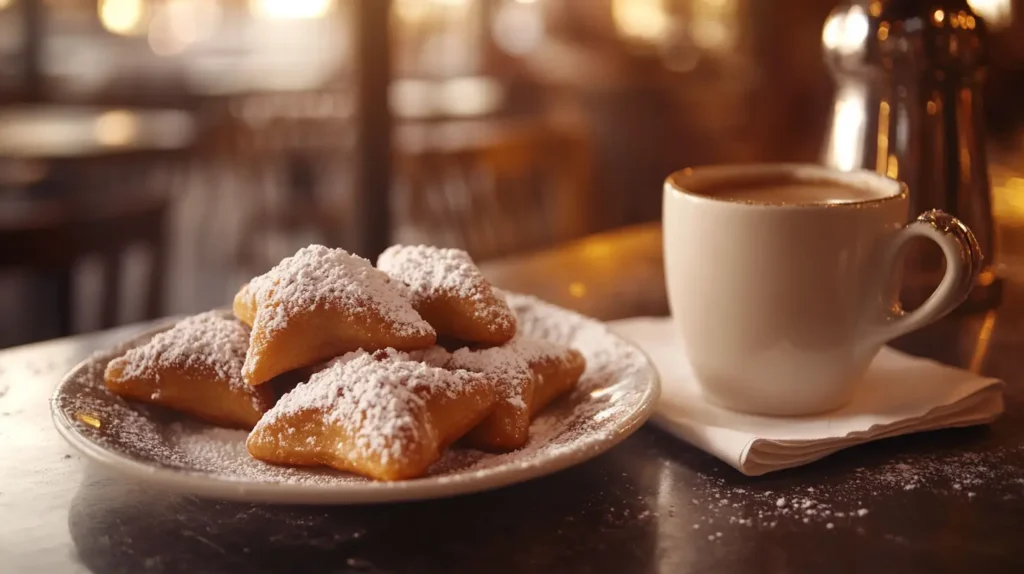Last Updated on March 7, 2025 by Simon
French Beignets and New Orleans Beignets may share the same name, but these beloved treats are far from identical. Both French beignets and New Orleans beignets delight with deep-fried goodness and a rich history, but they differ in more than just their origins. French beignets draw from centuries-old European traditions, featuring a light, airy texture and occasional fruit or cream fillings. In contrast, New Orleans beignets stand out as iconic square-shaped pastries, dusted generously with powdered sugar, paired with chicory coffee, and deeply rooted in Louisiana’s Creole culture.
Whether you’re planning a trip to the French Quarter or experimenting in your kitchen, understanding the differences between French Beignets and New Orleans Beignets will help you appreciate the unique charm of each version. From the dough and texture to their cultural significance, let’s dive into what sets these two sweet treats apart.
Table of contents
- A Tale of Two Beignets: Origins and History
- 1. Ingredients: Simple vs. Rich and Doughy
- 2. Texture and Appearance: Light Fritters vs. Puffy Squares
- 3. Serving Style: Sweet and Simple vs. Versatile and Varied
- 4. Cultural Significance: Tradition vs. Iconic Symbol of a City
- 5. Cooking Method: Deep Frying Techniques
- 6. Flavor Profile: Delicate vs. Decadent
- Summary: French Beignets vs. New Orleans Beignets at a Glance
- FAQs
- Final Thoughts: Which Beignet Should You Try?
- Related Posts You May Like
A Tale of Two Beignets: Origins and History
The word beignet comes from the French term meaning “bump” or “fritter,” and these pastries have been a staple of French cuisine for centuries. In France, beignets are traditionally made as a treat during holidays like Mardi Gras or Carnival. French settlers brought the recipe to Louisiana in the 18th century, where it took on a life of its own in New Orleans’ Creole culture.
However, what emerged in New Orleans wasn’t just a carbon copy of the French beignet. Influenced by local ingredients, cultural traditions, and even the city’s unique climate, the New Orleans beignet developed into a distinct pastry with its own flair.
Let’s break down the key differences between the two.
1. Ingredients: Simple vs. Rich and Doughy
One of the main differences between French beignets and New Orleans beignets lies in their ingredients.
French Beignets:
French beignets are more versatile in terms of the types of dough used. They can be made from pâte à choux (choux pastry), which is the same dough used for éclairs and cream puffs, or from a simple yeast dough. Choux pastry beignets are light, airy, and hollow on the inside, while yeast dough beignets are a bit denser.
French beignets may also include fruits or fillings, such as apples, pears, or jam. Some versions are made with crêpe batter and resemble fritters more than doughnuts.
Key Ingredients in French Beignets:
- Flour
- Eggs
- Butter
- Sugar
- Water or milk
New Orleans Beignets:

Bakers in New Orleans typically make beignets with a sweet yeast dough. They roll out the dough, cut it into squares or rectangles, fry it until golden brown, and coat it generously with powdered sugar. Unlike French beignets, New Orleans beignets are always served plain and never include fillings.
The signature style of New Orleans beignets is all about simplicity and indulgence. They’re deep-fried to achieve a crispy exterior while remaining soft and pillowy on the inside.
Key Ingredients in New Orleans Beignets:
- Flour
- Yeast
- Milk
- Sugar
- Butter
- Powdered sugar for coating
Fun Fact: The most famous place to enjoy a New Orleans beignet is at Café du Monde, an iconic coffee shop in the French Quarter that has been serving them since 1862.
2. Texture and Appearance: Light Fritters vs. Puffy Squares
The texture of French and New Orleans beignets differs significantly, primarily due to the type of dough and preparation method.
French Beignets:
French beignets made from choux pastry are lighter and airier, with a more delicate crust. They tend to puff up dramatically during frying, resulting in a crisp exterior and a hollow center. When made with yeast dough, French beignets are closer in texture to brioche doughnuts.
Their shape can vary, French beignets might be round, oblong, or irregular, and they can be small bite-sized pieces or larger portions.
New Orleans Beignets:
New Orleans beignets are thicker and denser than their French counterparts. They are almost always cut into square or rectangular shapes before frying, giving them a distinct appearance.
The texture is soft and chewy on the inside, with a slightly crispy outer shell. Once fried, they are generously coated in powdered sugar, sometimes to the point where they’re entirely white.
Pro Tip: New Orleans beignets are best enjoyed fresh and warm, often paired with a café au lait (coffee with chicory).
3. Serving Style: Sweet and Simple vs. Versatile and Varied
French Beignets:
People in France typically enjoy beignets as a snack or dessert. Different regions add their own flavors, such as orange blossom water, vanilla, or rum. Some French variations include fruit fillings or a coating of cinnamon sugar.
Mardi Gras celebrations often feature French beignets, served alongside other traditional Carnival treats.
New Orleans Beignets:
People in New Orleans enjoy beignets at any time of day, but they most often eat them for breakfast or as a late-night snack. Served with a heavy dusting of powdered sugar, they always come paired with a steaming cup of chicory coffee.
Unlike French beignets, New Orleans beignets never include fillings and rarely feature additional flavors beyond the dough and powdered sugar coating.
4. Cultural Significance: Tradition vs. Iconic Symbol of a City
French Beignets:

In France, beignets are a traditional treat, often tied to festivals and celebrations. They have been part of French culinary culture for centuries, and their recipes vary from region to region.
New Orleans Beignets:
New Orleans beignets have become a symbol of the city. They are deeply embedded in Creole and Cajun culture and are celebrated as part of the city’s rich culinary heritage. The beignet even holds the title of Louisiana’s official state doughnut.
New Orleans beignets are also iconic in the city’s tourism scene, with visitors flocking to places like Café du Monde and Morning Call to experience this sweet treat.
5. Cooking Method: Deep Frying Techniques
Both French and New Orleans beignets are deep-fried, but there are differences in the oil used and the frying process.
- French Beignets: Typically fried in vegetable oil or canola oil at a moderate temperature to achieve a light, golden color.
- New Orleans Beignets: Fried in hot oil (usually around 350°F/175°C) to create a darker, golden-brown exterior. The frying process is quick to ensure the inside stays fluffy while the outside gets crispy.
6. Flavor Profile: Delicate vs. Decadent
- French Beignets: Have a more delicate and nuanced flavor, often enhanced with citrus, vanilla, or floral notes.
- New Orleans Beignets: Are richer and sweeter, with a deep, fried dough flavor that pairs perfectly with powdered sugar and coffee.
Summary: French Beignets vs. New Orleans Beignets at a Glance
| Feature | French Beignets | New Orleans Beignets |
|---|---|---|
| Dough Type | Choux pastry or yeast dough | Sweet yeast dough |
| Shape | Varied (round, oblong, irregular) | Square or rectangular |
| Texture | Light and airy | Soft and chewy inside, crispy outside |
| Serving Style | Plain, filled, or flavored | Plain with powdered sugar |
| Cultural Significance | Traditional French treat | Iconic New Orleans symbol |
FAQs
Beignets and doughnuts both fall under the category of fried dough treats, but they differ in several key ways. You’ll typically find New Orleans beignets shaped into squares, without a hole in the center, and covered in powdered sugar instead of glaze. French beignets often take on a round or irregular shape and sometimes include fruit fillings, making them resemble fritters. In contrast, doughnuts use a different type of dough, tend to be sweeter, and feature a wide range of glazes and toppings.
You can make beignets without yeast by using choux pastry, a common choice for traditional French beignets. To prepare choux pastry, cook flour, butter, and water together before adding eggs, which creates a light, airy dough that puffs up during frying. However, New Orleans-style beignets use yeast to achieve their signature fluffy texture.
Powdered sugar is a defining feature of New Orleans beignets. The sugar coating adds sweetness to the otherwise plain dough and balances the rich, fried flavor of the beignets. This tradition likely stems from the influence of French cuisine, where powdered sugar is often used to garnish desserts. The powdered sugar also creates an iconic appearance, making the beignets instantly recognizable.
Final Thoughts: Which Beignet Should You Try?
If you love a more delicate and versatile pastry, the French beignet will satisfy your cravings. But if you’re seeking a decadent, deep-fried indulgence that’s uniquely tied to the vibrant culture of New Orleans, then the New Orleans beignet is a must-try.
Better yet why not try both? Each version offers a unique experience that highlights the beauty of cultural adaptation in food.
Related Posts You May Like
- How to Make Authentic French Jelly Beignets at Home – Discover the secrets to crafting soft, airy French beignets filled with fruity jelly. Learn traditional techniques and tips to achieve the perfect texture and flavor.
- The Secret to Homemade Beignets That Rival New Orleans – Want to recreate the magic of Café du Monde? Follow this guide for making fluffy, golden New Orleans-style beignets, complete with a generous dusting of powdered sugar.

